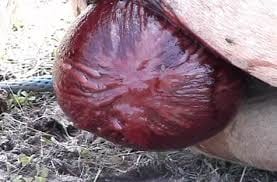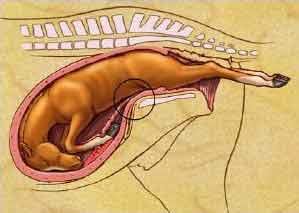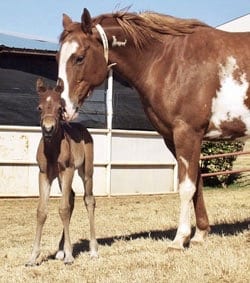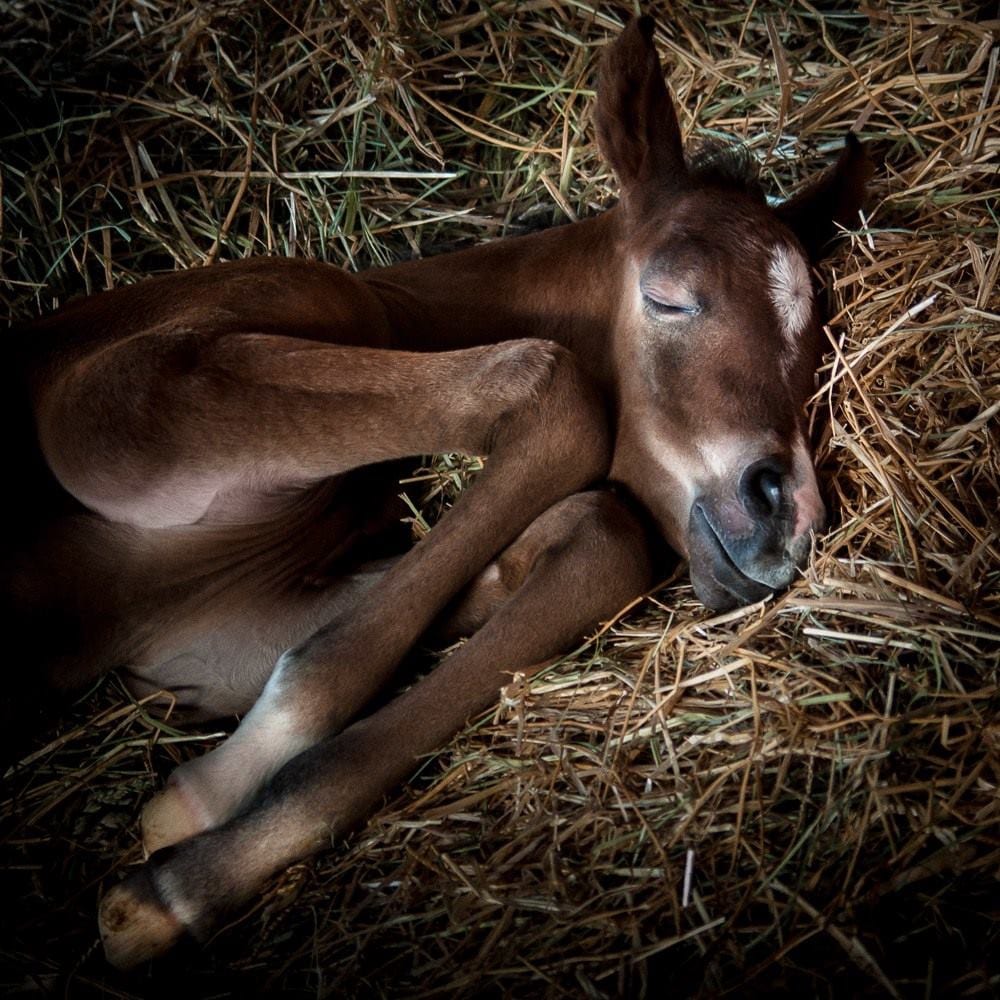You have prepped your beloved mare, spent hours researching bloodline crosses, booked the stallion, created the embryo and waited for about 320 days. The anticipation is a combination of excitement and anxiety. Will it be a filly or a colt? Will it be bay or sorrel? Will it be plain or have chrome? And you pray for a textbook delivery. However, no matter how much preparation or wishing, things often go awry. We spoke to a few of the top breeders in the horse industry about common foaling problems they have experienced.
Red Bag Delivery
Red Bag Delivery occurs when an intact fluid filled chorioallantois, or sac, protrudes out during birth, encapsulating the foal inside and risking asphyxiation. During a standard delivery this should burst, but if the placenta prematurely separates, a red bag emerges, hence the name. Red bag delivery can decrease the oxygen to the foal and remains the cause of 5-10% prenatal deaths. If caught early, the sac should be ripped or cut open to assist the birth.
 Top breeder Amy Gumz of Gumz Farms in Morganfield, Kentucky, explains, “Unless the mare presents with a history of bad foalings, you are not aware of problems until they present themselves. The exception of this would be red bag deliveries. Often a mare has a history of this issue, is known to be on fescue, which is the leading cause of red bag deliveries, or has been diagnosed with placentitis. It is critical that the foal is delivered quickly, removed from the placenta and embryonic sac and placed on oxygen. In spite of great care being taken, often these foals are born with neurological issues that may or may not be saved.”
Top breeder Amy Gumz of Gumz Farms in Morganfield, Kentucky, explains, “Unless the mare presents with a history of bad foalings, you are not aware of problems until they present themselves. The exception of this would be red bag deliveries. Often a mare has a history of this issue, is known to be on fescue, which is the leading cause of red bag deliveries, or has been diagnosed with placentitis. It is critical that the foal is delivered quickly, removed from the placenta and embryonic sac and placed on oxygen. In spite of great care being taken, often these foals are born with neurological issues that may or may not be saved.”
Professional Horseman Stephen Stephens who stands The Mechanic adds, “We usually only see red bags once every three years or so. We watch for the signs and our great staff is quick about dealing with it. We make sure we have the oxygen ready for every birth.”
Dystocia
 Dystocia, a prolonged or difficult birth, is typically associated to incorrect foal position, according to Dr. Patrick M McCue of Colorado State University. It is described as the “abnormal alignment of the head or forelimbs in the birth canal” and is common in approximately 1-2% of births. When this situation arises, if caught early, a manual attempt should be made to correct the foal position when possible.
Dystocia, a prolonged or difficult birth, is typically associated to incorrect foal position, according to Dr. Patrick M McCue of Colorado State University. It is described as the “abnormal alignment of the head or forelimbs in the birth canal” and is common in approximately 1-2% of births. When this situation arises, if caught early, a manual attempt should be made to correct the foal position when possible.
Debbi Trubee of North Farm, a breeder of many world and Congress Champion horses, describes, “I think the most common and easily fixable problem is a leg back or a presentation where one leg is quite a bit further back, but you can feel the hoof. In that case, pull the short leg only to try to clear the shoulder. Once the shoulder passes through, the rest will be okay. If you are missing a leg completely, you will have to sleeve up and reach in the mare pulling the leg forward.”
 In the case of dystocia where the birth is prolonged, Trubee suggests, “The first thing we do when a mare is in hard labor is sleeve up and reach through the vulva to be sure we have two feet and a nose. Once that’s established, we let the mare continue on her own with the birthing process and start helping her pulling the foal with the mare’s contractions.”
In the case of dystocia where the birth is prolonged, Trubee suggests, “The first thing we do when a mare is in hard labor is sleeve up and reach through the vulva to be sure we have two feet and a nose. Once that’s established, we let the mare continue on her own with the birthing process and start helping her pulling the foal with the mare’s contractions.”
Gumz discusses, “Dystocia is our most common problem, and usually it is due to large foals. Especially breeding to large stallions or with recipient mares carrying an undetermined sized foal, we have large foals with a high birth weight that require assistance to pull the foal out manually. Traditionally, the mare can be assisted, and the foal can be delivered with minimal problems.”
Placentitis
Placentitis, according to www.equine-reproduction.com, is defined as “inflammation of the placenta.” It is an infection mostly caused when bacteria permeates the cervical barrier and occurs in approximately 3-7% of all pregnancies. Warning signs include initial filling of the udder and if properly and treated early, ten out of twelve foals will survive. Treatment goals are to control the infection and reduce inflammation which can be done with medication. Trubee checks for this problem before foaling. “The only time we can really predict an immediate issue is if a mare has had placentitis. The incidence of a red bag delivery might be higher with an early detachment of the placenta.”
Recipient Mare Issues
 Many times, a producing mare will still be showing, and due to the AQHA multiple foal rule change in 2003, a mare is now allowed to produce multiple foals in the same breeding year. Therefore, a growing number of breeders are using recipient mares to carry embryos. However, this is not without its set of complications. Stephens commonly sees issues arise with ‘recip’ mares. “Instinctual bonding is not a problem,” Stephens discusses, “But the attitude of the recip mare can be.”
Many times, a producing mare will still be showing, and due to the AQHA multiple foal rule change in 2003, a mare is now allowed to produce multiple foals in the same breeding year. Therefore, a growing number of breeders are using recipient mares to carry embryos. However, this is not without its set of complications. Stephens commonly sees issues arise with ‘recip’ mares. “Instinctual bonding is not a problem,” Stephens discusses, “But the attitude of the recip mare can be.”
Stephens explains that many recipient mares are employed as such because they did not make a good show or human companion horses due to their insolence, and as every horse deserves a job, many mares like this are sent to be foal carriers. Stephens is always on the lookout for issues, “We have to be very careful when dealing with recip mares, especially during turnout. I have seen numerous times where the mare will side-kick the babies. Not through maliciousness, but because she is just arrogant and unaware of her surroundings. Their bad attitudes can also cause problems for handlers while in their stalls.”
Preparing for Foaling to Minimize Problems
 These vast and experienced breeding farms are often the safest places for foals to be born. Being equipped with the latest in high-tech gear and medical facilities allows the breeding managers to have quick detection to common foaling problems.
These vast and experienced breeding farms are often the safest places for foals to be born. Being equipped with the latest in high-tech gear and medical facilities allows the breeding managers to have quick detection to common foaling problems.
Gumz describes her operation, “We are blessed with a great staff with lots of experience. We have foal alerts in all mares and an attendant in the foaling barn. Our foaling center is climate controlled and equipped with slings and oxygen to assist the stressed foal. Our vet is on call and can get here in a short amount of time if the situation is dire.”
North Farm is also highly furnished. Trubee describes her facilities and all of the advanced technology, “We have our mares under cameras and we have a night  watchman once the mare’s milk is testing in the range of foaling and the other indicators look like it’s a go. Due dates are just a range and not indicative of when the mare is going to foal. We’ve had babies as early as 299 days and as late as over 365. We keep a foaling kit in the foaling barn with about everything we might anticipate needing: drugs for the mare, enema for the baby, towels, chains. It’s important to have everything handy as when an emergency hits, you need to move fast. Having our vet’s number on speed dial is also a must.”
watchman once the mare’s milk is testing in the range of foaling and the other indicators look like it’s a go. Due dates are just a range and not indicative of when the mare is going to foal. We’ve had babies as early as 299 days and as late as over 365. We keep a foaling kit in the foaling barn with about everything we might anticipate needing: drugs for the mare, enema for the baby, towels, chains. It’s important to have everything handy as when an emergency hits, you need to move fast. Having our vet’s number on speed dial is also a must.”
In Texas at Dry River Ranch, Stephens boasts of 16’ by 16’ foaling stalls and beautiful 25’ by 65’ long outdoor runs for mares and foals. He describes, “We have a state of the art foaling system, lab and neo-natal room and apartments right in the barn, but it is our great staff that takes care of everything. Manda and Ron are always on top of every situation, and their professionalism is second to none.”
Success
 While not all births can be problem free or textbook, it is often the difficult ones that can be so touching. Trubee laments, “If you do this long enough, chances are you will have a bad foaling where things just don’t go okay. There are times when, despite having knowledgeable people right there, you can’t save them all.”
While not all births can be problem free or textbook, it is often the difficult ones that can be so touching. Trubee laments, “If you do this long enough, chances are you will have a bad foaling where things just don’t go okay. There are times when, despite having knowledgeable people right there, you can’t save them all.”
Gumz explains why she continues to put her heart out there, “I always love a success story whether it is a difficult birth that excels or even a traditional delivery that becomes someone famous. It’s always nice to say; I helped to bring that one into the world.”
About the Author: An AQHA Professional Horseman, Mo West, currently lives in Danville, California. Assistant trainer at Busick Quarter horses, she enjoys training and coaching. Fishing is her second favorite activity, and she always has her beloved dog, Crash at her side whenever possible.








